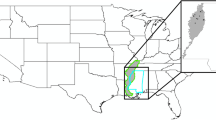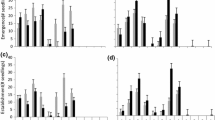Abstract
In this study, we examined the effects of water depth and temperature on seedling recruitment from a prairie wetland seed bank. We collected seed-bank samples from natural and restored prairie pothole wetlands in northwestern Iowa and combined them into a single sample. We examined seedling recruitment from this seed-bank sample in an experimental study using a factorial design of 4 temperature treatments (5° night and 15° day to 20° night and 30° day) and 3 water-depth treatments (0, 2, and 7 cm).
Principal Components Analysis showed that both water depth and temperature had significant effects on the composition of the seedling community as measured by changes in relative stem density and biomass. Water depth had its strongest effects on stem density while temperature had its strongest effects on biomass.
For the 22 most common species, stem density varied with water depth for 95% of the species and with temperature for 50% of the species. Most species with water depth responses had lower stem counts as water depth increased, and for the majority of species with temperature responses stem density increased with temperature.
Total, annual, and perennial species richness was negatively correlated with water depth. Total and annual species richness was positively correlated to temperature, while perennial species richness was unresponsive to temperature. In addition, species found at low elevations as adults emerged at higher rates in the deep water treatments while species that occurred at higher elevations as adults had their highest emergence rates in the low water treatments.
Our results suggest that differences in environmental conditions along coenoclines can affect the initial distribution of species emerging from the soil seed bank. Water depth sorted seedlings according to their adult water-depth tolerances, and temperature determined the proportion of annuals in the seedling community.
Similar content being viewed by others
References
Aarssen, L. W. 1983. Ecological combining ability and competitive combining ability in plants: toward a general evolutionary theory of coexistence in systems of competition. Am. Nat. 122: 707- 731.
Ågren, G. I. & Fagerström, T. 1984. Limiting dissimilarity in plants: randomness prevents exclusion of species with similar competitive abilities. Oikos 43: 369-375.
Allen, E. B. & Forman, R. T. T. 1976. Plant species removals and old-field community structure and stability. Ecology 57: 1233- 1243.
Begon, M. & Mortimer, M. 1986. Population Ecology. Sinauer Associates, Inc., Sunderland, Massachusetts, U.S.A.
de Swart, E. O. A. M., van der Valk, A. G., Koehler, K. J. & Barendregt, A. 1994. Experimental evaluation of realized niche models for predicting responses of plant species to a change in environmental conditions. J. Veg. Sci. 5: 541-552.
Drake, J. A. 1991. Community-assembly mechanics and the structure of an experimental species ensemble. Am. Nat. 137: 1-26.
Fowler, N. 1981. Competition and coexistence in a North Carolina grassland. II. the effects of the experimental removal of species. J. Ecol. 69: 843-854.
Galinato, M. I. & van der Valk, A. G. 1986. Seed germination traits of annuals and emergents recruited during drawdowns in the Delta Marsh, Manitoba, Canada. Aquatic Bot. 26: 89-102.
Gaudet, C. L. & Keddy, P. A. 1988. Predicting competitive ability from plant traits: a comparative approach. Nature 334: 242-243.
Gleason, H. A. 1926. The individualistic concept of the plant association. Bull. Torrey Bot. Club 53: 7-26.
Gleason, H. A. & Cronquist, A. 1991. Manual of vascular plants of Northeastern United States and adjacent Canada, 2nd edition. New York Botanical Garden, Bronx, New York.
Goldberg, D. E. 1987. Neighborhood competition in an old-field plant community. Ecology 68: 1211-1223.
Goldberg, D. E. & Werner, P. A. 1983. Equivalence of competitors in plant communities: a null hypothesis and a field experimental approach. Am. J. Bot. 70: 1098-1104.
Grace, J. B. 1987. The impact of preemption on the zonation of two Typhaspecies along lakeshores. Ecol. Monog. 57: 283-303.
Grillas, P., Van Wijk, C. & Bonis, A. 1991. Life history traits: a possible cause for higher frequency of occurrence of Zannichellia pedunculatathan of Zannichellia obtusifoliain temporary marshes. Aquatic Bot. 42: 1-13.
Grubb, P. J. 1977. The maintenance of species-richness in plant communities: the importance of the regeneration niche. Biol. Rev. 52: 107-145.
Harper, J. L. 1977. Population biology of plants. Academic Press, London.
Harris, S. W. & Marshall, W. H. 1963. Ecology of water-level manipulations on a northern marsh. Ecology 44: 331-343.
Hogenbirk, J. C. & Wein, R. W. 1992. Temperature effects on seedling emergence from boreal wetland soils: implications for climate change. Aquatic Bot. 42: 361-373.
Hubbell, S. P. & Foster, R. B. 1986. Biology, chance, and history and the structure of tropical rain forest tree communities. pp. 314- 329. In: Diamond, J. & Case, T. J. (eds), Community Ecology. Harper and Row, New York.
Hutchinson, G. E. 1961. The paradox of the plankton. Am. Naturalist 95: 137-145.
Kadlec, J. A. 1962. Effects of a drawdown on a waterfowl impoundment. Ecology 43: 267-281.
Keddy, P. A. 1982. Shoreline vegetation in Axe Lake, Ontario: effects of exposure on zonation patterns. Ecology 64: 331-344.
Keddy, P. A. & Constabel, P. 1986. Germination of ten shoreline plants in relation to seed size, soil particle size and water level: an experimental study. J. Ecol. 74: 133-141.
Keddy, P. A. & Ellis, T. H. 1985. Seedling recruitment of 11 wetland plant species along a water level gradient: shared or distinct responses? Can. J. Bot. 63: 1876-1879.
Keddy, P. A. & Reznicek, A. A. 1985. Vegetation dynamics, buried seeds, and water level fluctuations on the shorelines of the great lakes. pp. 33-58. In: Prince, H. H. & D'Itri, M. (eds), Coastal Wetlands. Lewis Publishers, Inc.
Leck, M. A. & Simpson, R. L. 1995. Ten-year seed bank and vegetation dynamics of a tidal freshwater marsh. Am. J. Bot. 82: 1547-1557.
Manly, B. F. J. 1986. Multivariate statistical methods: a primer. Chapman and Hall, London.
McKee, K. L., Mendelssohn, I. A., & Burdick, D. M. 1989. Effects of long-term flooding on root metabolic response in five freshwater marsh plant species. Can. J. Bot. 67: 3446-3452.
Millar, J. B. 1973. Vegetation changes in shallow marsh wetlands under improving moisture regime. Can. J. Bot. 51: 1443-1457.
Mithen, R., Harper J. L. & Weiner, J. 1984. Growth and mortality of individual plants as a function of 'available area'. Oecologia 62: 57-60.
Pederson, R. L. 1983. Abundance, distribution, and diversity of buried seed populations in the Delta Marsh, Manitoba, Canada. Ph.D. Dissertation, Iowa State University, Ames, Iowa.
Pederson, R. L. & van der Valk, A. G. 1984. Vegetation change and seed banks in marshes: ecological and management implications. Trans. North Am. Wildlife Nat. Res. Conf. 49: 271-280.
Pinder III, J. E. 1975 Effects of species removal on an old-field plant community. Ecology 56: 747-751.
Poiani, K. A. & Johnson, W. C. 1989. Effect of hydroperiod on seed-bank composition in semipermanent prairie wetlands. Can. J. Bot. 67: 856-864.
Putwain, P. D. & Harper, J. L. 1970. Studies in the dynamics of plant populations III. The influence of associated species on populations of Rumex acetosaand R. acetosellain grassland. J. Ecol. 58: 251-264.
Robinson, J. V. & Dickerson Jr., J. E. 1987. Does invasion sequence affect community structure? Ecology 68: 587-595.
Salisbury, E. 1971. The pioneer vegetation of exposed muds and its biological features. Phil. Trans. Roy. Soc. London B 259: 207- 255.
Seabloom, E. W. 1997. Vegetation dynamics in prairie wetlands. Ph.D. Dissertation, Iowa State University, Ames, Iowa.
Shmida, A. & Ellner, S.. 1984. Coexistence of plant species with similar niches. Vegetatio 58: 29-55.
Silander, J. A.& Antonovics, J. 1982. Analysis of interspecific interactions in a coastal plant community - a perturbation approach. Nature 298: 557-560.
Silander Jr., J. A. & Pacala, S.W. 1985. Neighborhood predictors of plant performance. Oecologia 66: 256-263.
Smith, L. M. & Kadlec, J. A. 1985. The effects of disturbance on marsh seed banks. Can. J. Bot. 63: 2133-2137.
Snedecor, G. W. & Cochran, W. G. 1989. Statistical Methods- 8th edition. Iowa State University Press, Ames, Iowa
Spence, D. H. N. 1982. The zonation of plants in freshwater lakes. pp. 37-125. In: Macfadyen, A. & Ford, E. D. (eds), Advances in ecological research. Academic Press, New York.
Squires, L. & van der Valk, A. G. 1992. Water-depth tolerances of the dominant emergent macrophytes of the Delta Marsh, Manitoba. Can. J. of Bot. 70: 1860-1867.
Stewart, R. E. & Kantrud, H. A. 1971. Classification of natural ponds in the glaciated prairie region. U.S. Fish and Wildlife Service Resource Publication No. 92.
Sutherland, J. P. 1974. Multiple stable points in natural communities. Am. Natur. 108: 859-873.
Thompson, K. & Grime, J. P. 1983. A comparative study of germination responses to diurnally-fluctuating temperatures. J. Appl. Ecol. 20: 141-156.
van der Valk, A. G. & Davis, C. B. 1976. The seed banks of prairie glacial marshes. Can. J. Bot. 54: 1832-1838.
van der Valk, A. G. & Davis, C. B. 1978. The role of seed banks in the vegetation dynamics of prairie glacial marshes. Ecology 59: 322-335.
van der Valk, A. G. & Davis, C. B. 1979. A reconstruction of the recent vegetational history of a prairie marsh, Eagle Lake, Iowa, from its seed bank. Aquatic Bot. 6: 29-51.
van der Valk, A. G. & Davis, C. B. 1980. The impact of a natural drawdown on the growth of four emergent species in a prairie glacial marsh. Aquatic Bot. 9: 301-322.
van der Valk, A. G., Squires, L., & Welling, C. H. 1994. Assessing the impacts of an increase in water level on wetland vegetation. Ecol. Appl. 4: 525-534.
van der Valk, A. G. & Welling, C. H. 1988. The development of zonation in freshwater wetlands: an experimental approach. pp. 145-158. In: Werger, H. J., During, M. J. A. & Willems, J. H. (eds), Diversity and pattern in plant communities. Academic Publishing. The Hague, The Netherlands.
Weiher, E. & Keddy, P. A. 1995a. The assembly of experimental wetlands. Oikos 73: 323-335.
Weiher, E. & Keddy, P. A. 1995b. Assembly rules, null models, and trait dispersion: new questions from old patterns. Oikos 74: 159-164.
Welling, C. H. 1987. Reestablishment of perennial emergent macrophytes during a drawdown in a lacustrine marsh. M.S. Thesis, Iowa State University, Ames, Iowa.
Welling, C. H., Pederson, R. L. & van der Valk, A. G. 1988. Recruitment from the seed bank and the development of zonation of emergent vegetation during a drawdown in a prairie wetland. J. Ecol. 76: 483-496.
Wilson, S. D. & Keddy, P. A. 1985. Plant zonation on a shoreline gradient: physiological response curves of component species. J. Ecol. 73: 851-860.
Wilson, S. D. & Keddy, P. A. 1986. Species competitive ability and position along a natural stress/disturbance gradient. Ecology 67: 1236-1242.
Rights and permissions
About this article
Cite this article
Seabloom, E.W., van der Valk, A.G. & Moloney, K.A. The role of water depth and soil temperature in determining initial composition of prairie wetland coenoclines. Plant Ecology 138, 203–216 (1998). https://doi.org/10.1023/A:1009711919757
Issue Date:
DOI: https://doi.org/10.1023/A:1009711919757




